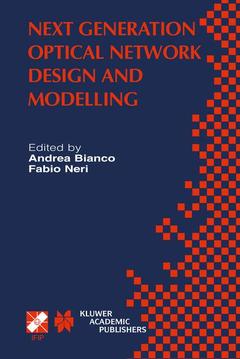Description
Next Generation Optical Network Design and Modelling, Softcover reprint of the original 1st ed. 2003
IFIP TC6 / WG6.10 Sixth Working Conference on Optical Network Design and Modelling (ONDM 2002) February 4-6, 2002, Torino, Italy
IFIP Advances in Information and Communication Technology Series, Vol. 114
Coordinators: Bianco Andrea, Neri Fabio
Language: English
Next Generation Optical Network Design and Modelling
Publication date: 09-2013
496 p. · 15.5x23.5 cm · Paperback
Publication date: 09-2013
496 p. · 15.5x23.5 cm · Paperback
Next generation optical network design and modelling
Publication date: 02-2003
496 p. · 15.5x23.5 cm · Hardback
Publication date: 02-2003
496 p. · 15.5x23.5 cm · Hardback
Description
/li>Contents
/li>
Optical networks are leaving the labs and becoming a reality. Despite the current crisis of the telecom industry, our everyday life increasingly depends on communication networks for information exchange, medicine, education, data transfer, commerce, and many other endeavours. High capacity links are required by the large futemet traffic demand, and optical networks remain one of the most promising technologies for meeting these needs. WDM systems are today widely deployed, thanks to low-cost at extreme data rates and high reliability of optical components, such as optical amplifiers and fixed/tunable filters and transceivers. Access and metropolitan area networks are increasingly based on optical technologies to overcome the electronic bottleneck at the network edge. Traditional multi-layer architectures, such as the widely deployed IP/ATM/SDH protocol stack, are increasingly based on WDM transport; further efforts are sought to move at the optical layer more of the functionalities available today in higher protocol layers. New components and subsystems for very high speed optical networks offer new design opportunities to network operators and designers. The trends towards dynamically configurable all-optical network infrastructures open up a wide range of new network engineering and design choices, which must face issues such as interoperability and unified control and management.
Preface. Committees. Part One: MAC Protocols. A QoS-Sensitive MAC for Slotted WDM Metropolitan Rings; J.D. Angelopoulos, N. Leligou, H. Linardakis, A. Stavdas. An Analytical Model for a Slotted WDM Metro Ring with A-Posteriori Access; K. Bengi. A Preemptable Slotted Access Protocol to Transport Variable Size Packets in All-Optical Ring LANs/MANs; M.R. Salvador, S. Heemstra De Groot, D. Dey. Comparison of Single-Hop and Multihop AWG Based WDM Networks; H. Woesner, M. Maier, A. Wolisz. Part Two: Burst Switching. Segmented Burst Switching: Enhancement of Optical Burst Switching to Decrease Loss Rate and Support Quality of Service; A. Maach, G. von Bochmann. Provision of End-to-End Delay Guarantees in Wavelength-Routed Optical Burst-Switched Networks; I. de Miguel, E. Kozlovski, P. Bayvel. QoS Performance of WR-OBS Network Architecture with Request Scheduling; E. Kozlovski, P. Bayvel. Dimensioning of FDL Buffers for Optical Burst Switching Nodes; C.M. Gauger. Part Three: Italian Projects on Optical Networks. Optical Packet Switching of IP Traffic; S. Bregni, G. Guerra, A. Pattavina. Dynamic DWDM Exploitation in Connection-Oriented Optical Packet Switches; F. Callegati, W. Cerroni, C. Raffaelli, P. Zaffoni. Variable-Size Packets in Slotted WDM Ring Networks; A. Bianco, M. Bonsignori, E. Leonardi, F. Neri. Ringo: a Demonstrator of WDM Optical Packet Network on a Ring Topology; A. Carena, V. Ferrero, R. Gaudino, V. De Feo, F. Neri, P. Poggiolini. A Wavelength Recognizing Switching Architecture for Omega Interconnection Networks; A. Borella, G. Cancellieri, P. Prosperi. Part Four: Switch Architecture. On the Performance of Optical Flow Routers Employing Wavelength Conversion; J.J. He, D. Simeonidou. Prioritized Buffer Management in Photonic Packet Switches for DiffServ Assured Forwarding; H. Harai, M. Murata. Assessment of Packet Loss for an Optical Packet Router with Recirculating Buffer; C. Develder, M. Pickavet, P. Demeester. Capability of Optical Code-Based MPLS (OC-MPLS); K. Kitayama, K. Onohara, M. Murata. Part Five: Protection and Restoration. Design of Static WDM Mesh Networks with Dedicated Path-Protection; S. De Patre, G. Maier, M. Martinelli, A. Pattavina. ZRESTORE: A Link Restoration Scheme with High Aggregation and No Reservation; S. Das, P. Verma, B.N. Jain, M. Gerla. Protection and Restoration Strategies in WDM Mesh Networks; G. Conte, M. Listanti, M. Settembre, R. Sabella. Dynamic Routing with Partial Information in Mesh-Restorable Optical Networks; M. Sridharan, R. Srinivasan, A.K. Somani. Part Six: Virtual Topology Design. A Study on the Efficacy of Regular Virtual Topology Design Heuristics for Optical Packet Switching; O. Komolafe, D. Harle, D. Cotter. A Design Method for Logical Topologies with Consideration of Wavebands; Y. Fukushima, S. Arakawa, M. Murata, H. Miyahara. Dynamic Establishment of All-Optical Connections in Wavelength-Routed Optical Networks Using Genetic Algorithms; D. Bisbal, F. González, I. De Miguel, J. Blas, J.C. Aguado, P. Fernández, R.M. Lorenzo, E.J. Abril, M. López. Part Seven: Wavelength Routed Networks. Capacity Expansion of Fiber Optic Infrastructure Networks Using Wavelength Division Multiplexing Systems; A. Dutta, P. Kubat. Performance Analysis of WDM Optical Networks with Wavelength Usage Constraint; J. Fang, R. Srinivasan, A.K. Somani. A Multistart Randomized Greedy Algorithm for Traffic Grooming on Mesh Logical Topologies; M.
© 2024 LAVOISIER S.A.S.




